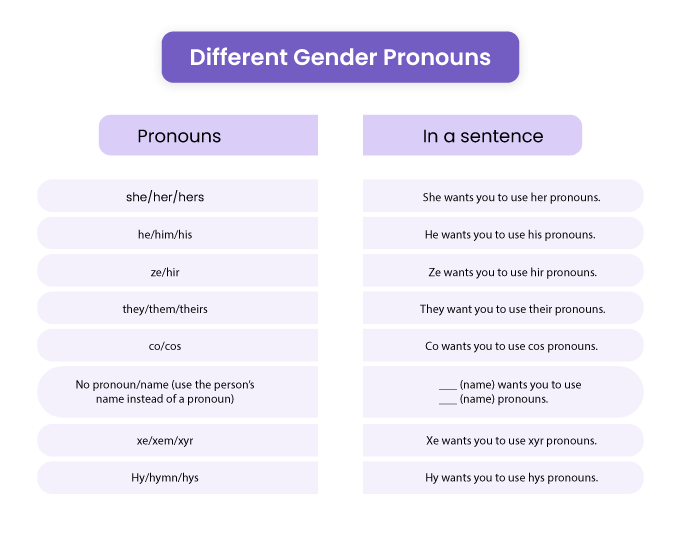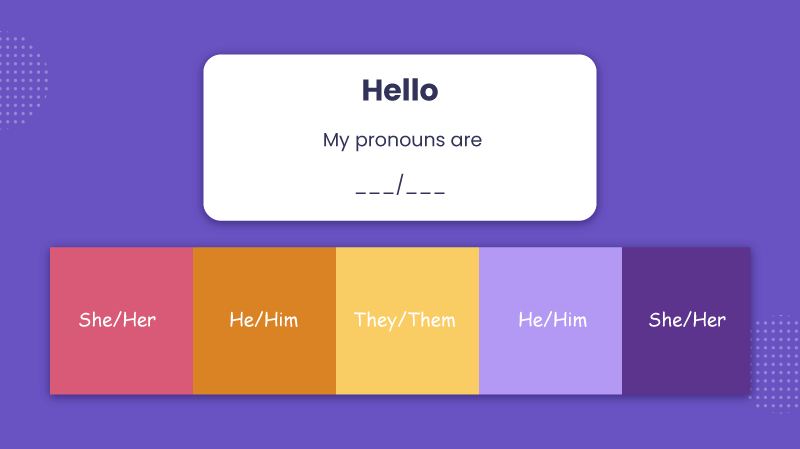6 Correct Ways To Use Gender Pronouns In The Workplace
If your company's top priority is diversity and inclusion, you can't afford to overlook the importance of using the correct gender pronouns in the workplace.
Employees with different expressions and gender identities are entering our workplaces, and discussing gender pronouns in the workplace is the need of the hour. Companies are now aware of and prioritize the employee experiences of LGBTQA+ individuals.
The important part is to emphasize diversity and inclusion for enhanced employee engagement. And crafting a great workplace culture with no room for discrimination in the workplace is the first step. Some companies have started including equal policies for LGBT employees, such as healthcare for same-sex couples, paid parental leaves, medical help for sex reassignment, and so on.
Drafting inclusive company policies is a great step. Still, these policies must be abided by managers and employees alike to create a safe and welcoming workplace for all employees.
So, let’s now primarily talk about gender pronouns in the workplace.
What are Gender Pronouns in the Workplace?
Gender pronouns are specific pronouns that a person uses to describe themselves or how they would like to be addressed by others. Examples of such pronouns are he, her, they, and more.
Let’s make it simple for you. A cisgender person would use she/her or he/him/his as their preferred pronouns. But non-binary employees would prefer pronouns like they/them/theirs because they do not identify with any gender per se.
Gender diverse or gender-nonconforming employees who do not identify as males or females challenge gender binaries and stereotypes at work and in society. These employees might prefer using gender-fluid pronouns like they/them, and you must acknowledge the same. It brings a sense of inclusivity and trust.
In addition, you must give importance to honorifics likes Ms. and Mr. and use Mx. for gender-neutral people.
Using employees' preferred names and pronouns is a more personal approach that demonstrates mutual respect and workplace equity.
Every employee deserves respect irrespective of their gender identity and preferred pronouns. Every employee has the basic right to articulate their preferred name and pronouns in the workplace in various settings such as formal and informal meetings, email signatures, client meetings, business cards, etc.
While practicing equal opportunity and recognition, make sure you do not misgender workers as it could be hurtful, angering, and result in employee stress and burnout.
Keep reading to know how you can sensibly use gender pronouns in the workplace without being prejudiced and biased.
6 Ways to Correctly use Gender Pronouns in the Workplace
1. Educating yourself about gender pronouns is the first step.
We teach our children from school about using binary pronouns and gender only. For example, he/she as singular and they/them as plural. But, this is the twenty-first century, and we must upgrade ourselves to include gender-inclusive language in our workplaces.
You must understand the non-binary, genderqueer, genderfluid workers (and whosoever chooses to use them) use they/them pronouns. As a manager or leader, you must respect their identity and promote an accepting workplace culture.
2. Never assume an employees’ pronouns.
Many workers might contradict their appearance and attributes to their gender or sexuality, whether at the grassroots or managerial level. But, that does not mean you will assume what pronouns they use.
You can address your employees using gender-neutral pronouns such as they/them until you learn what pronouns they use. To make it easier for employees to share their pronouns, make it a company-wide practice for employees to display their preferred pronouns on company communication channels. It will significantly lessen the stigma of sharing one's pronouns with others. But, never assume someone’s pronouns just by their appearance or attributes.
3. Ask their pronouns if you’re unsure.
If you hire regularly and have a diverse workforce, you must practice the ritual of “ask their pronouns.” If you’re unsure about someone’s pronouns, you must ask them politely and encourage others to do the same. Here are polite ways to ask.
- Hey, what are your pronouns?
- Do you mind if I ask what pronouns do you use?
- Hey, how would you like me to address you?
- Don’t mind me asking your pronouns; I just want to ensure I use the correct language to refer to you.
Note- try to avoid “preference” or “prefer” in your language. Pronouns are not a preference but an identity. And asking pronouns to people who appear to be queer or trans is problematic, so make a habit of asking everyone.
4. Practice before you preach
Before educating and promoting gender pronouns in the workplace, you must start with yourself. Especially if you’re cisgender, i.e., identify with the gender assigned at birth and use the pronouns he/him/she/her.
You can start by introducing yourself with your name and pronouns and then let the person take the opportunity to do the same. Example- “Hi, I am Dan Matthews, and my pronouns are he/him. And you are?”
Try practicing this in every group meeting or public forum where everyone can state their name and pronouns irrespective of gender. This is an excellent activity for showing solidarity with underrepresented gender minorities. Make this an ice-breaker activity where everyone has the chance to introduce themselves with their names and pronouns.
To make your workplace diverse and inclusive, you can start using pronouns in profiles, emails, business cards, and public spaces.
5. Respect employees’ gender transition
Someone who may have joined your company as a man but now identifies as another gender (because of sex -reassignment/transition) must be treated with equal respect and given equal recognition. There shall be no room for workplace harassment based on gender identity and sexuality.
There might be instances where someone undergoing a transition has a passport with their old identity. Or, if you’re asking for job verification, you might call their previous workplace who would have known them with a different gender identity.
To practice meaningful use of gender pronouns in the workplace, you must refer to workers the way they identify now, not who they were in the past. You must treat everyone’s identity and pronouns with respect and sensitivity.
Recommended Resource: 13 Ways To Promote Gender Equality In The Workplace
6. Stop using gendered language.
Using correct gender pronouns in the workplace is not an important aspect of gendered language. Some examples of gendered language include “Good morning ladies/guys.” Even some common phrases like “ladies and gentlemen” are problematic.
You must start using gender-neutral terms in your workplace. You must remain conscious of language and assumptions about people’s gender and identity. The language we think is inclusive might offend someone who defies gender norms and binaries.
Let’s take a look at some gender-inclusive phrases:
- Instead of “you guys,” use “you all.”
- Get rid of words like “dude,” “man,” or “bro.”
- Instead of using “ladies and gentlemen.” use “everyone” or “folks.”
- Get rid of words like “sir and ma’am” and refer to them by their names.
What are the different Gender Pronouns?
Here is the pronoun chart to ensure your employees meaningfully uses gender pronouns in the workplace.

Conclusion
The key to enhanced employee productivity is creating an equitable workplace culture that respects every worker’s identity. And to curate an inclusive workplace culture, you must use the correct gender pronouns for every worker, irrespective of their gender and sexuality.
















